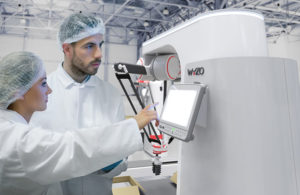
The Wyzo robot features a human machine interface designed for ease of use.
The robotics firm Wyzo (Ecublens, Switzerland) recently debuted a novel pick-and-place sidebot, which is suitable for various uses, including lightweight applications within pharmaceutical facilities. Pharmaceutical Processing World recently profiled the robot, which can support up to 80 picks per minute.
To learn more about the robot, we reached out to Wyzo CEO Frank Souyris, who describes the types of pharmaceutical applications the technology can handle. Souyris also provides information on how the robot can operate side-by-side with humans without protective barriers or performance compromises.
What kind of pharmaceutical applications do you envision for the Wyzo robot?
Souyris: Thanks to the high-tech robotic arm and built-in or external vision systems, the Wyzo sidebot is suitable for any type of pharmaceutical products within the following specifications:
- Maximum speeds of 80 cycles per minute for products that weigh half a kilogram;
- Reduced speeds of 30 to 50 cycles per minute for products that are up to one kilogram.
Wyzo can be used in the pharmaceutical industry for top loading applications, machine loading, kit packaging, bottle handling, and similar applications.
Can you briefly summarize how the Delta robot led to the Wyzo?

Frank Souyris
Souyris: Wyzo is the brainchild of Demaurex S.A., the pioneer of the Delta robot. The company was the first to produce industrial Delta robots and to develop a real-time controller for them. With more than 20 years of experience in parallel structure robots, control technologies for such architecture and deep application expertise, the Wyzo team is well-positioned to service even the most challenging pharmaceutical applications. The Delta is considered the benchmark for best practice in terms of high-speed pick-and-place technology, and the company has more than 4,000 robots installed worldwide. Building on this wide industry knowledge and expertise, the Wyzo team equipped the new sidebot with a high-tech robotic arm, vision systems, integrated pneumatic, electric and vacuum controls, as well as state-of-the-art pick-and-place software for fast and flexible production.
What kind of safety features and sensors does the Wyzo have?
Souyris: While traditional pick-and-place robots are large and work on fully automated lines separated from operators by protective doors, Wyzo’s advanced safety system allows it to collaborate with humans nearby. First of all, Wyzo features a unique brand-new generation of safety controller. It is the first safety controller for parallel structure Delta robots that provides safe speed, position control, and maximum safe torque control.
Through its advanced sensor technology and two built-in safety scanners, Wyzo constantly monitors its surroundings for the presence of human activity, allowing it to maximize performance when on its own and also to slow to a safe operating speed when a human is near. As a result, compared to cobots, which are also used in the pharmaceutical industry, Wyzo offers higher speeds when operators are nearby (30 to 50 cycles per minute versus around 10 cycles per minute for cobots) and significantly higher speeds when operators are not detected (up to 80 cycles per minute).
Wyzo also features a new direct-drive actuator, LiveDrive, developed by Genesis Robotics & Motion Technologies, our Canadian partner. This leading-edge actuation technology enabled the very first direct-drive Delta robot. With no need for gears, belts, or lubrication above the working area, LiveDrive actuators simplify the drivetrain, deliver increased performance, and eliminate any risk of oil leakage or contamination. Furthermore, the LiveDrive’s low inertia and fast stopping times avoid the risk of injury. It includes two encoders for safety redundancy.
Can you briefly summarize how an operator can program the robot? I saw in the press release that an operator could program the robot without the use of a programming language. How unique is the robot in terms of its ease of use?
Souyris: Wyzo’s Human Machine Interface (HMI) is simplified for intuitive use by operators with no prior training in automated solutions. Its mobile terminal is as easy to operate as a smartphone and requires neither script nor programming to get Wyzo up and running. An operator configures tasks, which are, in essence, a series of pick and place instructions or a straightforward configuration of the processes to be performed. There is no specific structured programming language to be learned. Based on our industry expertise, all possible operating parameters are predefined in the instruction, including different types of end-effectors, sensors (vision or alternative solutions) and environment (conveyors, fixed positions, etc.). An operator can create new tasks with products running onto a conveyor belt without any specific know-how.